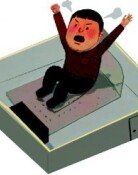Obamas Asian tour
U.S. President Barack Obama will take a tour to Japan, South Korea and Malaysia next week. Expectations are running high on the upcoming Asian tour, because his visit to Asia was postponed due to U.S. government shutdown in late last year.
The U.S. president would have different agendas for each country, but his agendas will gradually take shape in the regional context of the countries he visits. The most important factor is the situation of Chinas mounting influence and power, and the issue of how the U.S. will cope with it.
In his first term in office, President Obama declared that the U.S. will "pivot" to Asia, and alluded that his country will rebalance policy and resources from the Middle East to Asia. The U.S. administration seeks to focus on pivot to Asia, but the world is not very cooperative. The urgency of the situation in Syria, the Ukraine crisis and Iranian nuclear development demand attention from Washington.
In the meantime, China has been rising. China is the biggest trading partner of other Asian countries. Chinese companies and consumers are essential to the manufacturing network in the region, while Chinese peoples tourism is increasingly important to neighboring countries. Regardless of whether they like it or not, no countries in Asia can afford to disregard Beijing and the Chinese people. They cannot afford to do everything China wants, but they must heed to them nonetheless.
Such rebalancing is important not only to Asians but also to Americans. If Asian governments have been planning their diplomatic relations to conform to the geographical "magnetic north" of Washington over the past several decades, they now must deal with the two different magnetic norths of Washington and Beijing.
President Obama should demonstrate that Washington has important and permanent interests in the region, and that it will not only defend but also actively promote it.
Tangible progress of the Trans-Pacific Partnership (TPP), a new trade structure that spans the Pacific, will be the starting point to this end. However, the U.S. should avoid the risk of TPP being interpreted as efforts to contain and blockade China. In short, we have too many interlinked interests, including trade and finance, environment and regional stability, to concentrate on the strategy of blockade. China in the 21st Century is definitely not the Soviet Union in the mid-20th Century.
Furthermore, President Obama should concurrently deal with escalating tension between China and Japan, and between Japan and Korea. However, Washington`s capacity to play critical role is limited. The U.S. can expedite dialogue, but it will hardly afford to handle and achieve that many things.
There is another issue that should be included in Obamas agendas in Seoul and Tokyo. It is none other than North Koreas nuclear program and threat since this program imposes on regional stability. Currently, unbound by any international treaties or ongoing dialogue, North Korea is currently making progress with its nuclear weapons and missile programs. We should assume that Pyongyang is making progress on both fronts.
However, what shall we do? There is no sign that Pyongyangs collapse is imminent, while we cannot afford to strongly support the claim that China will make a tough decision required to bring change to Pyongyang.
It is painful and hardly agreeable to think, but it seems that we have no option other than making efforts to find a right mix of stick and carrot, which would allow us to freeze the Norths nuclear program, if we cannot remove the program by engaging Pyongyang anew.
Track records are not very impressive, but threat is real and growing. With passage of time, the problem will become all the more difficult to solve. Seoul and Washingtons consent on goals and strategy will be the starting point for the two allies to effectively cope with the Norths threat. President Obamas visit is an opportunity for the two sides to consolidate this.







